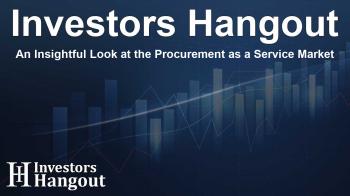An Insightful Look at the Procurement as a Service Market

The Procurement as a Service Market: A Bright Future Ahead
Recent analysis indicates that the Procurement as a Service (PaaS) market is on a remarkable growth trajectory. Projected to expand from USD 7.86 billion to USD 17.17 billion between the years 2025 and 2032, this sector is poised to experience a compound annual growth rate (CAGR) of 11.8%. Such growth is driven primarily by organizations aimed at boosting their operational efficiency while minimizing overhead expenses.
Key Insights from Market Analysis
Predictions from market research reveal a significant shift in how companies handle their procurement needs. In fact, strategic outsourcing is anticipated to dominate the industry with a market share of 30.7% in 2025. Large enterprises will account for over 60% of the overall procurement as a service market by the same year.
Moreover, by sector, manufacturers are expected to capture a market share of 36.6%, highlighting the essential role of efficient procurement processes in production. Geographically, North America is expected to command a leading 38.3% share, establishing itself as a pivotal region in this development.
Drivers of Growth in Procurement as a Service
A significant factor driving the growth of the PaaS market is the increasing emphasis on cost optimization and operational efficiency among organizations. As businesses recognize the advantages of outsourcing their procurement tasks, there’s a noticeable shift towards utilizing external expertise to facilitate sourcing.
PaaS empowers companies by allowing them to streamline their procurement functions, thereby focusing on core competencies. This approach not only reduces costs but also enhances the organization’s overall agility and responsiveness in managing supplier relationships.
Challenges Facing the Market
Despite the positive outlook, data security concerns pose a potential challenge to market growth. As procurement platforms necessitate access to critical organizational data, companies are understandably cautious regarding the sharing of sensitive details. This reluctance to divulge vital information could somewhat hinder the anticipated demand for procurement as a service solutions.
The Role of Digital Transformation
As digital transformation continues to reshape industries, the demand for procurement as a service is expected to surge. Organizations are increasingly gravitating towards digital and cloud-based solutions, which offer the scalability and integration capabilities essential in today’s fast-paced business environment.
This ongoing shift allows companies to enhance collaboration across their operations, further emphasizing the importance of agile procurement mechanisms that aid in significantly improving workflow efficiency.
Emerging Trends in Procurement as a Service
The PaaS market is being revolutionized by the implementation of cutting-edge technologies such as artificial intelligence (AI) and machine learning (ML). These innovations are not only enhancing operational efficiency but are also informing decision-making processes, thus reflecting an increasingly sophisticated approach to procurement.
Additionally, as organizations prioritize regulatory compliance and sustainable practices, the demand for PaaS providers proficient in these areas is on the rise. Such providers offer the necessary resources and automated tools needed to navigate complex compliance landscapes.
Competitive Landscape and Industry Developments
The procurement as a service market is characterized by a robust competitive environment, featuring key players such as Accenture plc, Genpact, and IBM Corporation. Recent advancements, such as the launch of GEP's Total Orchestration Solution, exemplify the innovative strides being made within the industry.
Moreover, strategic partnerships, like that of Genpact with ServiceNow, underscore the trend of integrating advanced technologies into procurement functionalities, ultimately enhancing productivity and experience.
Frequently Asked Questions
What is Procurement as a Service (PaaS)?
PaaS is a business model that allows companies to outsource their procurement processes, benefiting from specialized expertise and efficiency improvements.
What factors are driving the growth of the PaaS market?
Key growth drivers include cost optimization, increased operational efficiency, and a growing trend of outsourcing procurement functions.
What challenges does the PaaS market face?
Data security concerns may limit the adoption of PaaS solutions as companies hesitate to share sensitive information.
How is technology influencing PaaS?
Technologies like AI and machine learning are enhancing procurement decision-making and operational efficiency.
Who are the main competitors in the PaaS market?
Key players include Accenture, Genpact, IBM, and various other firms that are innovating to capture market share.
About The Author
Contact Henry Turner privately here. Or send an email with ATTN: Henry Turner as the subject to contact@investorshangout.com.
About Investors Hangout
Investors Hangout is a leading online stock forum for financial discussion and learning, offering a wide range of free tools and resources. It draws in traders of all levels, who exchange market knowledge, investigate trading tactics, and keep an eye on industry developments in real time. Featuring financial articles, stock message boards, quotes, charts, company profiles, and live news updates. Through cooperative learning and a wealth of informational resources, it helps users from novices creating their first portfolios to experts honing their techniques. Join Investors Hangout today: https://investorshangout.com/
The content of this article is based on factual, publicly available information and does not represent legal, financial, or investment advice. Investors Hangout does not offer financial advice, and the author is not a licensed financial advisor. Consult a qualified advisor before making any financial or investment decisions based on this article. This article should not be considered advice to purchase, sell, or hold any securities or other investments. If any of the material provided here is inaccurate, please contact us for corrections.

